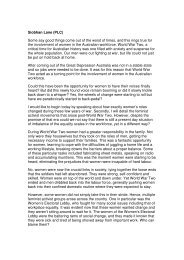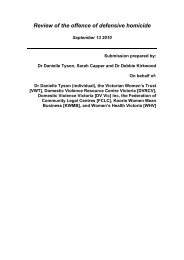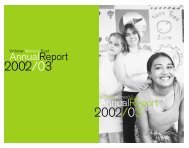entire document here - The Victorian Women's Trust
entire document here - The Victorian Women's Trust
entire document here - The Victorian Women's Trust
You also want an ePaper? Increase the reach of your titles
YUMPU automatically turns print PDFs into web optimized ePapers that Google loves.
<strong>The</strong> Big PicturegroundwaterA large part of rural and remote Australia is dependent on thesupply of water from aquifers. <strong>The</strong> cities of Perth and Adelaideare also partly dependent. Each aquifer being used to supplywater is divided into a number of groundwater managementunits. A unit can supply several hundred farming enterprises,a small town or even a mine.Across Australia t<strong>here</strong> are currently 535 such operational unitssupplying thousands of users. Each of these users is licensedto pump a specified amount of water during a prescribed timeof year. 3 Only 14% of these operational units have some or allof their water use metered. 4For decades people were allowed to sink bores into these majoraquifers and leave them flowing continuously. This has resultedin a significant drop in water pressure and, consequently, flowrates. For instance, across the Great Artesian Basin initial flowrates were more than 10 ML per day. <strong>The</strong>se days, flow rates arein the range of 0.01–6 ML per day. 5T<strong>here</strong> is now a national program underway to cap these boresso that water is released only on demand. Funding to completethis program has been included in Prime Minister Howard’srecently released A national plan for water security. 6In a number of places t<strong>here</strong> are so many people pumpingwater (both legally and illegally) that the total volumebeing removed from aquifers is in excess of the volumethat enters by recharge in an average climate year.In such a situation, the aquifer is described as being‘over-allocated’.A national assessment of Australia’s water resources in 2000indicated that 161 of the 535 groundwater management unitswere either nearly fully allocated or over-allocated. 7In our two biggest food-producing areas, the Murray-DarlingBasin and the Great Artesian Basin, the known allocationsof water already exceed the volumes of water that can bepumped on a sustainable basis.As with surface water, the use of groundwater has increaseddramatically since the early 1980s. In 1983–84 total groundwateruse was 2634 GL. In just over a decade, this rose to 4962 GL – anincrease of 88%. 8 It’s now also known that, in areas of certaingeomorphology, aquifers and rivers are linked so that if too muchwater is removed from the aquifer, available water in the river alsodecreases. Conversely, if too much water is pumped from the river,the recharge of the aquifer diminishes. 9What we must also take account of is that the adverse effectsof excessive groundwater pumping on stream flow can accumulateover a long period. A recent report to the Federal Governmentpresented case studies from the USA and China which show thatthe full effects of excessive groundwater pumping were not felt forseveral decades. 10STATEIrrigationT<strong>here</strong> is no free lunch <strong>here</strong>. It’s very simple– every litre of water you pump out ofthe ground reduces river flow by the sameamount.Dr Richard Evans, principal hydrogeologist, Sinclair Knight Merz,Australian Financial Review, 24 May 2007, p. 10Table 1. Mean annual groundwater use (GL) by different use categories in all states and territoriesUrban/IndustrialRural In situ Total (GL)New South Wales 643 160 205 0 1008Victoria 431 127 54 10 622Queensland 816 265 541 0 1622Western Australia 280 821 37 0 1138South Australia 354 23 42 24 419Tasmania 9 7 4 0 20Northern Territory 47 48 33 0 128Australian Capital Territory 2 0 3 0 5TOTAL 2582 1451 919 34 4962In most parts of the mainland, groundwater use is regulated through licensing. It is a major source of water for muchof rural Australia and is also used in manufacturing and most household activities (apart from drinking).Source: National Land and Water Resources Audit, Canberra, Australian water resources assessment 2000, NLWRA,Canberra, 2001, p. 58.34 <strong>Victorian</strong> Women’s <strong>Trust</strong> - Our Water Mark






